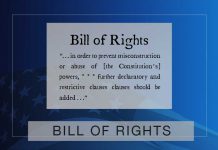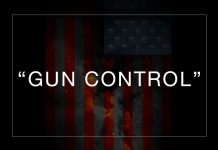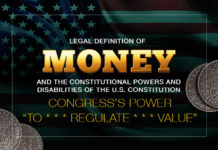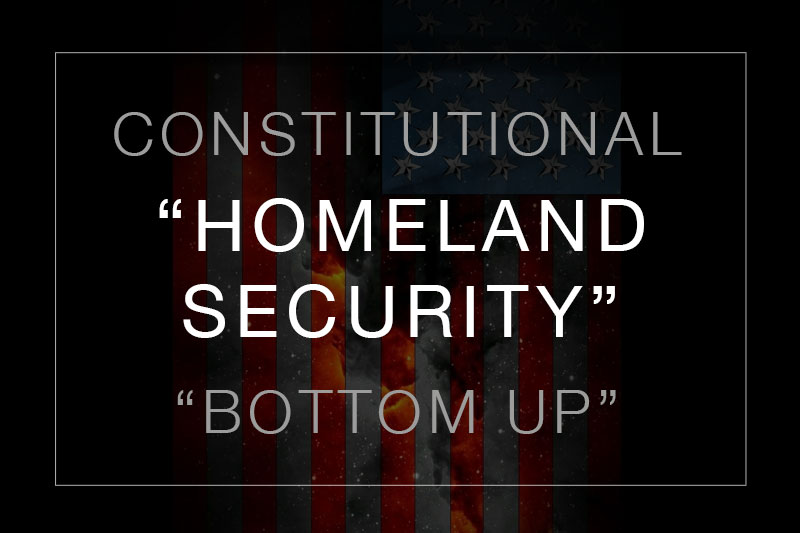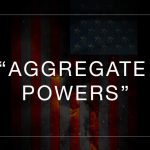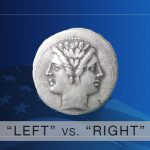Last Updated on October 7, 2021 by Constitutional Militia
Conversely, a proper ruling under the “well regulated Militia” approach would result in recognition of an absolute personal right for almost all common Americans to keep certain types of firearms: that is, a right which is not subject to (is immune from) any regulation—“reasonable,” “compelling,” or otherwise —because “the right of the people to keep and bear Arms” is actually the consequence of an individual constitutional duty to do so. And no government, National, State, or Local, can have any power whatsoever—under color of some supposedly “compelling interest” or any other excuse—to prohibit or inhibit the fulfillment of a constitutional duty that is “necessary to the security of a free State”, upon the continued existence of which the very legitimacy of that government depends. (This conclusion would hold even if “the right of the people to keep and bear Arms” were largely an “individual right,” provided that it could serve as an instrument in aid of “[a] well regulated Militia”—that is, provided the Second Amendment’s two clauses were construed as mutually supporting, rather than as separate from and independent of one another.)
Indeed, because the Second Amendment declares—and everyone in the United States, public official and private citizen alike, is bound by its declaration—that “[a] well regulated Militia” is “necessary to the security of a free State”, the government’s most “compelling interest” must be the preservation of “well regulated Militia”. For this very purpose, the Second Amendment commands that “the right of the people to keep and bear Arms, shall not be infringed”. Therefore, the government can have no “compelling”—or, for that matter, even any legitimate “interest”—in disarming common Americans, but instead must have a “compelling” interest in allowing them to arm themselves. Where the Second Amendment is concerned, the “compelling governmental interest” theory is unidirectional. Once again, though, this chain of reasoning depends upon construing the Second Amendment’s two clauses as inextricable.
A pragmatist should also consider that, although an “individual right” “to keep and bear Arms” would to some degree support “[a] well regulated Militia”, because some individuals would choose to possess firearms useful for Militia service, nonetheless the Militia approach (if properly enacted into law) would guarantee that almost every able-bodied man and woman in the United States, from sixteen to sixty years of age, and not a conscientious objector, would be suitably armed. Thus, the Militia approach would in fact provide more of a practical “individual right”, in terms of the number of people actually in possession of firearms in their own homes and on the streets (and trained to use those firearms safely and effectively), than would the “individual-right theory”. As for individuals less than sixteen years of age, no prudent person doubts that their access to and use of firearms are properly subject to supervision, in the first instance by their parents or guardians, and where that fails by public authority. Individuals more than sixty years old would almost all have served in the Militia in earlier years, and would always be allowed to volunteer for Militia service thereafter, and on the basis of that previous service and present possibility alone would be entitled to an absolute right to possess firearms.
In addition, patriots should remember that only the Militia approach can serve the vital purpose of the Second Amendment, which is not to promote hunting, target shooting, or other “sporting” or “recreational” uses of firearms (although the Militia approach would protect these activities too), but instead is to arm “the people” so as to provide “the security of a free State” through “well regulated Militia.” By itself, an “individual right” to possess firearms cannot protect this country against the imposition of a police state by rogue public officials. For what good will arms in individuals’ hands prove to be against large-scale para-militarized police forces and other instruments of oppression, without thoroughgoing organization of those individuals and legal authority for their collective action in defense of their liberties? The Militia are the constitutional institutions that provide both—which is why the Second Amendment declares them to be “necessary to,” not simply useful let alone optional for, “the security of a free State.”
Assume, though, for purposes of argument, that somehow or other the Supreme Court stumbles into a decision favorable to Heller on the “individual-right theory”. What can one expect will be gained? Perhaps not much more than Americans already have now. For, in all likelihood, a favorable decision will be very narrow.
A basic rule of constitutional adjudication is that the Supreme Court ought not to write an opinion that is broader than the legal issues and the facts actually before it in the case under consideration. Anything beyond that amounts to an “advisory opinion”, which lies outside the Court’s constitutional jurisdiction. If the decision is in favor of Heller, it will be to some degree consistent with the Constitution. If to some degree consistent with the Constitution, it will be written by one of the Justices who is at least a lukewarm constitutionalist. And even a lukewarm constitutionalist will respect the rule against “advisory opinions”.
The facts in Heller’s case are peculiarly susceptible to a narrow ruling, too. First, Heller himself is a “licensed armed protection officer” who works for a private security company. So he has been investigated and trained, and is supervised, far in excess of an ordinary citizen. A majority of Justices might very well consider this a basis for voiding the D.C. gun law as an “unreasonable regulation”, or as serving no “compelling governmental interest”—but only as against Heller and others similarly situated, not as against just any ordinary citizen. Second, Heller is asserting a right to keep a working firearmand ammunition in his home for purposes of self-protection there. A majority of Justices might accept this particularized, localized purpose, without opining on any other possible purposes, or especially other venues, for private citizens’ possession of firearms. Third, Heller desires to keep a medium-caliber centerfire pistol in his home. A majority of Justices might agree that this is an “appropriate” firearm for self- defense, and that therefore Heller’s possession of it is protected by the Second Amendment, while at the same time denying that other types of firearms—such as so-called “assault rifles”, big- bore “sniper rifles”, or short-barreled shotguns—are embraced by that constitutional guarantee. Any good decision on the second and third of these points would doubtlessly be welcomed by all patriots. Yet such a decision might be so tailored to the extremism of the District’s law as to have little applicability in other jurisdictions, where “gun control” is less draconian.
Even if the Court rules that an ordinary citizen has a constitutional right to keep some type of handgun or other firearm “appropriate” for self-protection in his home, it may not explain how a resident of the District of Columbia (or any other large city with strict “gun-control” ordinances) who does not already have such a firearm in his home can arrange to acquire one, particularly if the District prohibits or stringently regulates the retail sale or other transfer of firearms within its territory. What good is a “right” for most people to possess firearms in their homes without a “right” to obtain firearms in the first place, typically through the channels of private commerce? And before anyone concludes that such a “catch- 22” decision is unlikely, he should compare Stanley v. Georgia, 394 U.S. 557 (1969), with United States v. Reidel, 402 U.S. 351 (1971). If that is the result, rather than settling matters once and for all Heller will simply spawn further complex, contentious, and costly litigation in the lower courts.
Besides all this, the overriding fact in Heller is blatantly political and propagandistic in nature: namely, that the District of Columbia is the capital of the United States—and if not the “murder capital” of this country today, certainly a perennial challenger for that dubious title. The Justices will naturally try to avoid any decision that they imagine might exacerbate, or even might simply appear to exacerbate, this situation. Also, the District is a metropolis that follows the myopic pattern of such other large cities as Boston, New York, Chicago, and so on, in having strict “gun control”, as well as high rates of violent crime. Unable to fathom (or unwilling openly to admit on the pages of the United States Reports) that “gun control” actually stimulates and facilitates crime by empowering criminals as against their victims, the Justices will doubtlessly try to avoid any decision that might throw into doubt the rationality and legitimacy of the “gun-control” regimes in all of those cities. What, after all, would Mayor Bloomberg say? The strange reality of the present era is that jurists who do not seem to lose sleep over being directly responsible for tens of millions of premeditated homicides-for- hire by abortion undoubtedly would cringe in the face of editorials in the Washington Post or the New York Times, claiming on the basis of the post hoc ergo propter hoc fallacy that, as a result of some decision barely favoring the Second Amendment, narco-gangster killings, drive-by shootings, or massacres perpetrated in “gun-free” schools and shopping malls by drugged-up zombies had multiplied in those cities. And what if a series of sensational “gun crimes” coincidentally occurs just before the Supreme Court actually decides Heller?
How broad, or how narrow, a favorable decision in Heller might be also depends upon what sort of “individual right” a majority of the Justices deigns to recognize. To be sure, a very clear-cut, specific “right of the people to keep and bear Arms”—immune from “infringement” by “reasonable regulations” or “compelling governmental interests”—could be derived from the dozens and dozens of pre-constitutional Militia statutes in the Colonies and independent States, were the “Militia” interpretation the basis for decision: namely,
*Who enjoys the right—essentially every common American above the age of sixteen years (thus defining “the people.”)
*What “Arms” does the right encompass—every type of firearm that could have a use with respect to Militia service, including “assault rifles,” “sniper rifles,” “combat shotguns,” and other small arms of contemporary regular light infantry (thus defining “Arms.”)
*Where and how can the right be exercised—by personal acquisition of “Arms” in the free market, and personal possession of “Arms” in every American’s home and on the streets (thus defining “keep and bear.”)
*When can the government prohibit such behavior—never (thus properly defining a “right,” because it cannot be “infringed.”)
In the absence of the “Militia interpretation” and reliance on the pre-constitutional Militia statutes, though, the Justices will essentially have to make up “the right of the people to keep and bear Arms” as they go along—on the basis of historical speculation, lawyers’ arguments, and the Justices’ own political and sociological prejudices that hide behind the labels “reasonable regulation” and “compelling governmental interest”. As with anything ersatz, although their concoction may perhaps suffice for the immediate purpose, it will nonetheless not be the real thing, and therefore will prove not good enough for the long haul.
But one superficially read in constitutional history may object: Did not the Founding Fathers speak, again and again, to the meaning of “the right of the people to keep and bear Arms”? Certainly that is the technique often employed in naive studies of the Second Amendment: namely, marshaling statements attributed to James Madison, Thomas Jefferson, George Mason, and even Alexander Hamilton, in order to establish legal principles by reference, deference, and adherence to personalities. Now, these statements may themselves be facts—in the sense that such and so is what some Founder actually said or wrote. But their substance consists, not necessarily of historical or legal truths, but only of the opinions of the men who made them—even if those men were in high public office at the time. Fundamentally, this is why so-called “legislative history” such as records of legislative debates were rightly considered incompetent evidence during the founding era and for many decades thereafter: “Doubtless, the intention of the Congress which framed and of the States which adopted [a constitutional] Amendment must be sought in the words of the Amendment; and the debates in Congress are not admissible as evidence to control the meaning of those words.” United States v. Wong Kim Ark, 169 U.S. 649, 698 (1898). (Today,“legislative history” is often employed by lawyers and judges for the purpose of expanding or contracting laws beyond their actual terms—and legislative debates are often intentionally larded with tendentious statements in aid of this subversive procedure, either by legislators who opposed a law and want to see it constricted, or by legislators who supported a broader version of a law than was actually enacted, or both.)
In addition, where the Constitution “asserts a certain right, or lays down a certain principle of law * * * , it speaks for the entire people.” Davis v. Burke, 179 U.S. 399, 403 (1900).
Therefore, its meaning must be derived from its own words, as construed according to then-contemporary rules of interpretation upon which “the entire people” —that is, average Americans—would have relied, not just from the opinions of a handful of even the most illustrious statesmen of that time. For part three click below.







